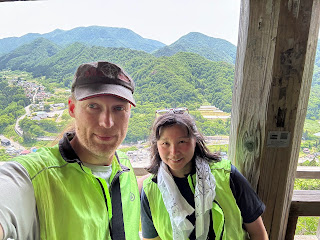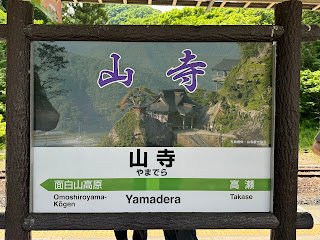A lot of times when you see some tourist thing advertised, it's either hyperbole or straight up exaggeration. So when we decided to head to Yamadera to "climb the thousand stairs" I was...not doubtful but skeptical that the temple really had 1000 stairs. It was certainly an impressive, sprawling collection of buddhist buildings built into the side of a mountain.
 |
| View from the city below |
Yamagata is about an hour west of Sendai Station by train, so we biked up to the closest station to our hotel on the east side of town, Nakanosakai, and spent the next 90 minutes heading west. Yamagata is a small tourist town with a ton of omiyage (souvenir) shops on the roads leading out of the station to the base of the temple climb.
One thing that actually shocked me was that until March of THIS YEAR, the Yamagata train station did not accept IC cards. IC Cards are the magnetic fare cards that you can charge up (Suica, Pasmo, etc) and use instead of buying tickets at machines with cash. We have been to some tiny stations in the middle of nowhere with one-man train cars that don't use IC, but a major tourist destination like Yamagata not even using technology from twenty years ago was quite a surprise.
As we left the station, we couldn't help but notice an enormous pot on the side of the road.
 |
| "Japan's Number One Imoni Festival" |
Every year in September, the city holds an Imoni festival. If you, like me, wondered what an Imoni festival is, Imoni is a kind of taro soup. This pot is actually built on top of a large grill pit and during the festival, they fill up the 6.5 meter diameter pot with over 3 tons of taro root, 1.2 tons of beef, and other ingredients and cook a soup that serves 30,000 people. It take about 4.5 hours to cook the soup. Wild.
About a half mile walk from the big pot was the start of the temple climb.
 |
| That looks...steep. |
Ascending the first set of stairs we came across a very tourist-y area selling a bunch of stuff along with some old temple buildings. As we kept going up, the tourist stuff faded away and there were a lot of gravestones, temple buildings, and other carvings into the rock of the cliff.
After about 600 steps, I was starting to believe them. The original temple, Risshakuji, was built in 860, and was the northern edge of the empire at the time. Also the famous poet, Basho, composed one of his most well-known haiku here about the stillness of the area:
閑けさや 岩にしみいる 蝉の声
Shizukesa ya/ Iwa ni shimiiru/ Semi no koe
Ah, the Quiet, but piercing the Rocks — the Cry of the Cicada
Brevity and all that. What do you expect when you only get 17 syllables to work with? In any case as we got higher up the mountain, the views got better and less crowded.
At the top of the mountain (and it was OVER 1,000 steps!), above even the temple, was Godaido, a building built in the 1700's over the edge of the cliff at the top of the mountain with the best view of the area. It was also where all the school kids on their field trip were getting their pictures taken, so it was a bit crowded and noisy, but the view was spectacular.
 |
| First with a couple of dorks in the way |
 |
| A dork-less view |
Fleeing the mobs of middle schoolers, we walked back down the 1,000 steps (I'll never doubt them again) and stopped at a little shop/restaurant for the sakuranbo (cherry) ice cream that was a specialty here. It turns out it wasn't just a specialty but, and I quote, "Among the top 11 ice cream stands in Japan" according to an NHK television show. First of all, you can just say "We're number 11". Second of all, yeah the ice cream was really good. Their sakuranbo actually was ranked first in the nation, according to this show, which consisted of a rather large woman visiting ice cream shops and...eating ice cream.
It was still relatively early when we got back on the train to head back, so we decided to visit Masamune Date's mausoleum in Sendai. It's a much smaller version of Toshogu in Nikko that we visited on our first day up here, but with the same intricate and often gaudy style (known as the Momoyama period). Date was one of most power daimyo of the Tokugowa Shogunate and is directly responsible for establishment of Sendai as a major city. He also had a cool helmet, which is used as an icon all over Tohoku for just about everything
 |
| Musubimaru - MAJET (Japanese English Teaching) logo |
 |
| Random fence in Sendai |
So, we took the local tourism bus, The Loople, to Zuihouden, the shrine and mausoleum of the Date clan. Getting off the bus, we walked around the corner and saw
 |
| That looks...steep...again. |
After the climb up and down Yamadera, seeing an 8% grade leading up to the shrine was a bit disheartening, but we slogged our way up. Zuihouden was impressive, with a lot of the same kind of decoration and scrollwork, but with different subject matter, all very well restored. Most of Sendai was flattened during WWII, and many of the buildings here did not survive. Most everything was rebuilt in the 70's and 80's as faithfully as possible to the original designs.
We had thought about checking out the castle, but were getting tired and hungry (we hadn't had a meal yet today), so we walked to the subway and headed back to Sendai Station where just a few blocks away was an Ichiran Ramen shop!
 |
| Extra garlic and green onions, firm noodles, light broth, extra chili. Heaven. |
Ichiran has so spoiled us that it's hard to enjoy ramen in the US. It's always too thick, the noodles are too heavy, the pork is a slab of meat instead of a thin slice. Yep, we're Japan snobs, we know. It was the perfect way to end a long day of walking. We headed back to the station pick up our bikes only to find...a citation. Apparently we parked in a spot that required a sticker to be purchased. The good news is, the citation was quite nice and basically asked us politely to go get a sticker. They also would have liked us to pay for the day's parking, but as we have no way of doing that (it was after 5PM and we're leaving tomorrow morning) we will forever be parking fugitives in Nakanosekai.
Across the street from the station in this nice, upscale area, was an oddly named "Dining Izakaya" (bar that serves food)















No comments:
Post a Comment